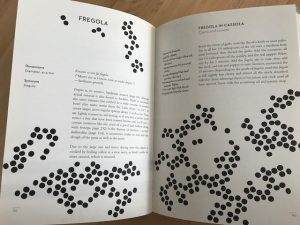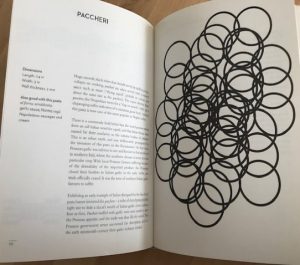First, thank you to everyone who took part in the guessing contest for our newest pasta over the last week! We had so much fun looking at the guesses: everything from bowties to lasagna to pappardelle! Second, congratulations to the lucky two (whose names we’re not revealing due to privacy, at this time)!!
There are a lot of really great noodle shapes, and we had a bit of a hard time deciding what shape to develop next. Linguini is the common name for our newest shape – the etymology (or root) of the word means “little tongues,” which, as the authors of the book The Geometry of Pasta, Caz Hildebrand and Jacob Kenedy (2010) write, accurately describes the shape: it’s long like spaghetti, but flattened to an ellipse in a cross-section, like the shape of a tongue. As a shape, linguini benefits from two different properties: being sturdy like a cylinder, but also having the folding properties of a flat noodle.

As the authors write, linguini is one of a trio of very similar noodles, along with the bavette and trenette. Bavette is a more ancient term for a near-identical pasta to the linguini, which comes to us from French, where a “bib” is called a “bavette”. And trenette is a bit like a square-cut linguini. These three shapes are often used with seafood- and tomato-based sauces. There is a lot of room for contrast between the shape, feel and textures of each noodle and ingredients of the sauce. This is the noodle for us!
The Sourdough Difference
As with all of our sourdough pastas, we also use our signature European-style sourdough in this newest shape. Our sourdough culture is the heart of what makes our pastas special. We’ve written about the sourdough difference before, but will briefly summarize briefly it here. With fermentation, the sourdough helps to break down different components of the grains, such as the gluten (protein), making it easier to digest. The fermentation also makes many of the nutrients more bioavailable: easier for our bodies to absorb and take them in. We’ve also noticed that the fermentation enhances the flavours of the grains, so there is quite a different in the flavour of the Classic rotini, the hemp rotini and the quinoa rotini.
A little bit of help goes a long way
We had a bit of help getting here: expanding our long pasta line further and bring you the sourdough linguini: many of you will be aware that Kaslo Sourdough applied for and was successful in receiving funding from the governments of B.C. and Canada through the Canadian Agricultural Partnership (CAP) under the Agri-Innovation Program, which was designed to strengthen and grow businesses like ours that belong to the Canadian agriculture and agri-food sector. We were a good fit for the program. We’re a food manufacturing company reliant on high-quality Canadian grains, that is also invested in supporting Canadian farmers. The funding from CAP supported the development of our sourdough spaghetti last year, and now also developing our sourdough linguini.
We invite you to try out our sourdough linguini when next you are in the mood for pasta. It’s truly a wonderful and versatile shape to add to any pantry. With the official rollout underway, our linguini will soon be available at most of the grocers that have our other varieties. If you haven’t seen it on the shelf yet, let us know and we’ll see what we can do. In addition, you are always able to order directly from us through our online shop.
An extra note
A short note on Hildebrand and Kenedy’s book: it’s a wonderful mix of history, culture, recipes, and graphic design! We had a lot of fun flipping through these pages and discovering some of the unique shapes out there. Some of these noodle shapes are recognizable and familiar (gnocci, campanelle, and ziti). But other shapes are at least very uncommon to North America, even if you visit a Mediterranean import store. Have you ever heard of the fregula or paccheri (images below)? Hildebrand writes in the Introduction: “The idea for this book began when I was thinking about the Italians’ preoccupation with choosing the right pasta shape to go with the right sauce. As they will tell you, this make the difference between pasta dishes that are merely ordinary and truly sublime” (pg. 7). The authors are really speaking our language here!


Funding to support the Kaslo Sourdough Project has been provided by the Governments of Canada and British Columbia through the Canadian Agricultural Partnership, a federal-provincial territorial initiative. The program is delivered by the Investment Agriculture Foundation of BC.
Back to news


